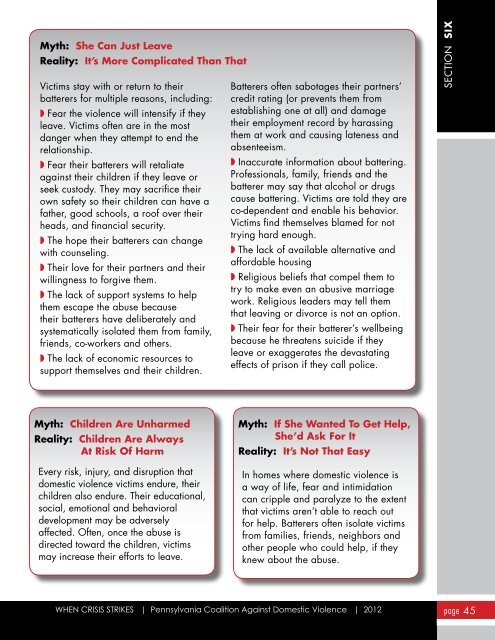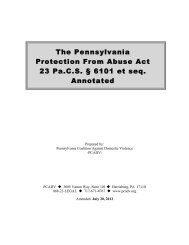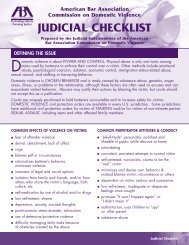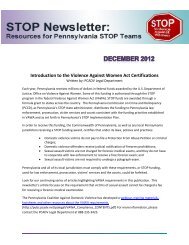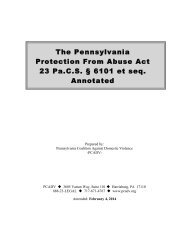Toolkit with Report Form - Pennsylvania Coalition Against Domestic ...
Toolkit with Report Form - Pennsylvania Coalition Against Domestic ...
Toolkit with Report Form - Pennsylvania Coalition Against Domestic ...
Create successful ePaper yourself
Turn your PDF publications into a flip-book with our unique Google optimized e-Paper software.
Myth: She Can Just Leave<br />
Reality: It’s More Complicated Than That<br />
Victims stay <strong>with</strong> or return to their<br />
batterers for multiple reasons, including:<br />
◗ Fear the violence will intensify if they<br />
leave. Victims often are in the most<br />
danger when they attempt to end the<br />
relationship.<br />
◗ Fear their batterers will retaliate<br />
against their children if they leave or<br />
seek custody. They may sacrifice their<br />
own safety so their children can have a<br />
father, good schools, a roof over their<br />
heads, and financial security.<br />
◗ The hope their batterers can change<br />
<strong>with</strong> counseling.<br />
◗ Their love for their partners and their<br />
willingness to forgive them.<br />
◗ The lack of support systems to help<br />
them escape the abuse because<br />
their batterers have deliberately and<br />
systematically isolated them from family,<br />
friends, co-workers and others.<br />
◗ The lack of economic resources to<br />
support themselves and their children.<br />
Batterers often sabotages their partners’<br />
credit rating (or prevents them from<br />
establishing one at all) and damage<br />
their employment record by harassing<br />
them at work and causing lateness and<br />
absenteeism.<br />
◗ Inaccurate information about battering.<br />
Professionals, family, friends and the<br />
batterer may say that alcohol or drugs<br />
cause battering. Victims are told they are<br />
co-dependent and enable his behavior.<br />
Victims find themselves blamed for not<br />
trying hard enough.<br />
◗ The lack of available alternative and<br />
affordable housing<br />
◗ Religious beliefs that compel them to<br />
try to make even an abusive marriage<br />
work. Religious leaders may tell them<br />
that leaving or divorce is not an option.<br />
◗ Their fear for their batterer’s wellbeing<br />
because he threatens suicide if they<br />
leave or exaggerates the devastating<br />
effects of prison if they call police.<br />
Section Six<br />
Myth: Children Are Unharmed<br />
Reality: Children Are Always<br />
At Risk Of Harm<br />
Every risk, injury, and disruption that<br />
domestic violence victims endure, their<br />
children also endure. Their educational,<br />
social, emotional and behavioral<br />
development may be adversely<br />
affected. Often, once the abuse is<br />
directed toward the children, victims<br />
may increase their efforts to leave.<br />
Myth: If She Wanted To Get Help,<br />
She’d Ask For It<br />
Reality: It’s Not That Easy<br />
In homes where domestic violence is<br />
a way of life, fear and intimidation<br />
can cripple and paralyze to the extent<br />
that victims aren’t able to reach out<br />
for help. Batterers often isolate victims<br />
from families, friends, neighbors and<br />
other people who could help, if they<br />
knew about the abuse.<br />
When Crisis Strikes | <strong>Pennsylvania</strong> <strong>Coalition</strong> <strong>Against</strong> <strong>Domestic</strong> Violence | 2012 page 45


